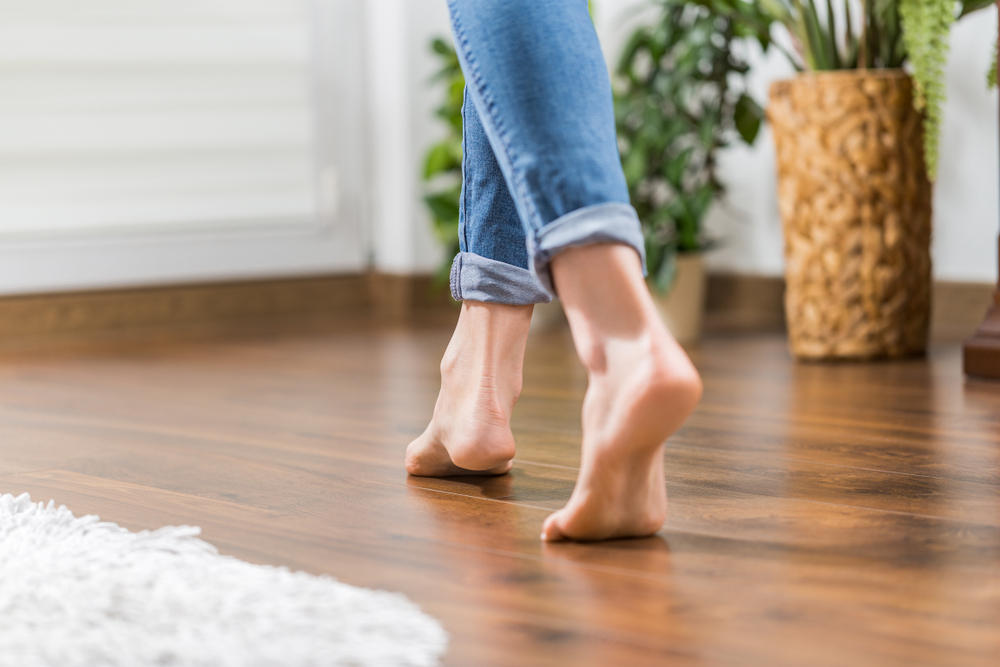How to Test Your Laminate Flooring Sample

The prospect of laying new flooring in the home can be an expensive and time-consuming process. Have the confidence of knowing you chose the perfect product for your space by taking the time to test your laminate flooring samples. Knowing exactly how they will look, feel, and hold up over time makes it easy to make that final decision.
Laminate flooring makes a popular choice for rooms throughout the home. Not only does it provide the look of hardwood at a fraction of the cost, but many products are also waterproof, making them an ideal choice for rooms frequently exposed to moisture. Because laminate is a man-made product, it comes in a wide variety of styles and finishes from which to choose. The same tests can be performed on luxury vinyl and hardwood flooring if a category of product hasn’t been chosen yet.
Test Laminate Flooring Samples Before You Commit
Bring in the Light
All flooring can look different in natural light versus artificial light. Different placements within the same room and different times of day can affect the color of a flooring sample. Move it around the space and look at it repeatedly over the course of 24 hours. Make sure in all light conditions that it looks flattering with the existing wall color, cabinetry, and furnishings.
Don’t be afraid to order samples in the color scheme you initially gravitate toward as well as colors you wouldn’t normally steer toward. Once they are in the space, the colors that most flatter the room may surprise you. Look at both warm and cool tones to see which one coordinates with the existing decor.
How Does it Feel?

The flooring beneath your feet needs to feel comfortable when you’re wearing shoes, socks, or running around barefoot. Some products offer integrated underlayments while others require an underlayment added. Place the samples down on the floor and walk over them. Floors with a smooth finish can he slick in socks. Laminate that is richly textured may seem rougher on bare feet. While walking on the floor, make sure to test whether or not the shoes you love leave marks on the floor with the pressure of your weight.
Test the Durability
Different products can vary greatly in durability. Start by seeing how easily the flooring scratches and dents. Try dropping a weight or using a sharp object to drag across the sample. Next, try staining the flooring with various food products. Clean the stain up right away and then repeat the process, letting the stain sit a bit longer. Make sure to use the same cleaning products you plan on using on the flooring. Make sure the cleaning process doesn’t leave a residue or alter the finish of the laminate.
Consider the rigors of everyday life in the space, particularly if you have pets. Add any additional tests that will help ensure it will hold up to what life throws at it. Walk in heels, jump in cleats, or drag a chair over the flooring to mimic day-to-day life.
Tip: Even after installing flooring, keep an extra cut-off or piece on hand to try new products on before trying them on the installed flooring.
Compare AC Ratings

Laminate flooring is a multi-layer material. The top layer, or wear layer, is the part that provides a texture, look, and finish to the material. The layers below are more about comfort. How well that wear layer holds up to everyday life is what gives it a classification.
All laminate flooring receives an AC (Abrasion Class) rating. The AC rating will range anywhere from an AC1 to an AC5. Laminate flooring with an AC rating between AC1 and AC3 are designed for residential use, with AC1 being the least durable and AC3 being the most durable within the residential range. Laminate products with an AC 4 or AC5 rating are intended for both heavy residential and commercial use.
AC1 laminate floors are suitable for low-traffic areas of the home while AC3 floors are necessary for higher-traffic areas, such as foyers and living rooms. When looking for ultimate durability designed to stand up to households with many children or pets, you may want to opt for the commercial-grade AC4 or AC5 ratings. Flooring with a higher AC rating are typically more of an investment but they also boast a longer lifespan, making it less likely for repairs and replacements in the near future.
Subject it to Temperature Changes
Extreme humidity, heat, or cold can alter flooring. Consider the temperatures of the room and make sure to expose the flooring to those temperatures. This is especially important when the laminate is used in rooms that experience extreme temperature swings, such as a basement. Let the flooring sample acclimate to the space for at least 24 hours to see how it would adjust to the temperature of the room.
Once you’ve put the flooring samples through all the tests, it should be clear to see which products make the best choice for your home. Most laminate flooring is easy to install, making it a great project for the avid weekend warrior. If the flooring is running throughout the entire home, hiring professionals will make fast work of a time-consuming project. If you aren’t sure whether to take it on as a do-it-yourself project or not, try clicking together a few of the samples and test to see if it is a process you feel comfortable with. New flooring has a way of breathing life into a space and grounding a complete look. Test your favorites to discover the one that will be a foundation for the style of your home for years to come.




